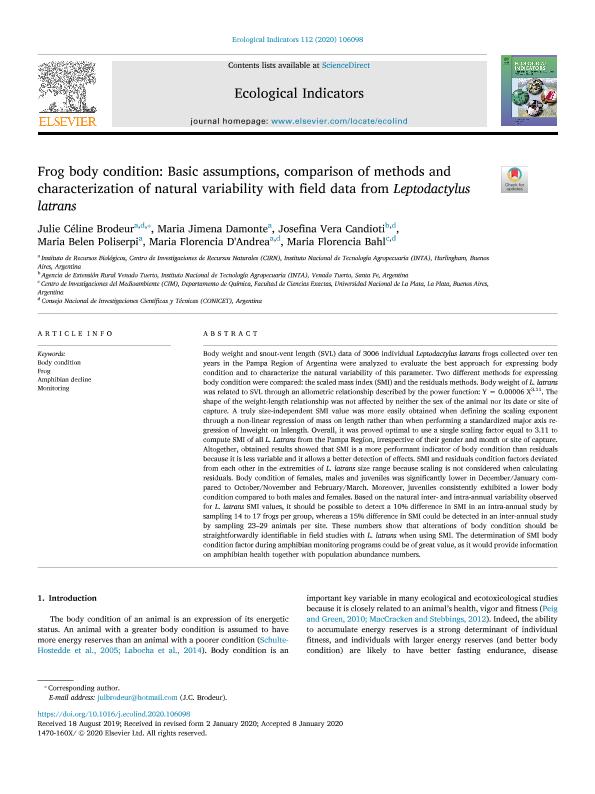Artículo
Frog body condition: Basic assumptions, comparison of methods and characterization of natural variability with field data from Leptodactylus latrans
Brodeur, Celine Marie Julie ; Damonte, Maria Jimena; Vera Candioti, Josefina
; Damonte, Maria Jimena; Vera Candioti, Josefina ; Poliserpi, Maria Belen; D'Andrea, Maria Florencia; Bahl, Maria Florencia
; Poliserpi, Maria Belen; D'Andrea, Maria Florencia; Bahl, Maria Florencia
 ; Damonte, Maria Jimena; Vera Candioti, Josefina
; Damonte, Maria Jimena; Vera Candioti, Josefina ; Poliserpi, Maria Belen; D'Andrea, Maria Florencia; Bahl, Maria Florencia
; Poliserpi, Maria Belen; D'Andrea, Maria Florencia; Bahl, Maria Florencia
Fecha de publicación:
05/2020
Editorial:
Elsevier Science
Revista:
Ecological Indicators
ISSN:
1470-160X
Idioma:
Inglés
Tipo de recurso:
Artículo publicado
Clasificación temática:
Resumen
Body weight and snout-vent length (SVL) data of 3006 individual Leptodactylus latrans frogs collected over ten years in the Pampa Region of Argentina were analyzed to evaluate the best approach for expressing body condition and to characterize the natural variability of this parameter. Two different methods for expressing body condition were compared: the scaled mass index (SMI) and the residuals methods. Body weight of L. latrans was related to SVL through an allometric relationship described by the power function: Y = 0.00006 X3.11. The shape of the weight-length relationship was not affected by neither the sex of the animal nor its date or site of capture. A truly size-independent SMI value was more easily obtained when defining the scaling exponent through a non-linear regression of mass on length rather than when performing a standardized major axis regression of lnweight on lnlength. Overall, it was proved optimal to use a single scaling factor equal to 3.11 to compute SMI of all L. Latrans from the Pampa Region, irrespective of their gender and month or site of capture. Altogether, obtained results showed that SMI is a more performant indicator of body condition than residuals because it is less variable and it allows a better detection of effects. SMI and residuals condition factors deviated from each other in the extremities of L. latrans size range because scaling is not considered when calculating residuals. Body condition of females, males and juveniles was significantly lower in December/January compared to October/November and February/March. Moreover, juveniles consistently exhibited a lower body condition compared to both males and females. Based on the natural inter- and intra-annual variability observed for L. latrans SMI values, it should be possible to detect a 10% difference in SMI in an intra-annual study by sampling 14 to 17 frogs per group, whereas a 15% difference in SMI could be detected in an inter-annual study by sampling 23–29 animals per site. These numbers show that alterations of body condition should be straightforwardly identifiable in field studies with L. latrans when using SMI. The determination of SMI body condition factor during amphibian monitoring programs could be of great value, as it would provide information on amphibian health together with population abundance numbers.
Palabras clave:
AMPHIBIAN DECLINE
,
BODY CONDITION
,
FROG
,
MONITORING
Archivos asociados
Licencia
Identificadores
Colecciones
Articulos(CCT - LA PLATA)
Articulos de CTRO.CIENTIFICO TECNOL.CONICET - LA PLATA
Articulos de CTRO.CIENTIFICO TECNOL.CONICET - LA PLATA
Articulos(SEDE CENTRAL)
Articulos de SEDE CENTRAL
Articulos de SEDE CENTRAL
Citación
Brodeur, Celine Marie Julie; Damonte, Maria Jimena; Vera Candioti, Josefina; Poliserpi, Maria Belen; D'Andrea, Maria Florencia; et al.; Frog body condition: Basic assumptions, comparison of methods and characterization of natural variability with field data from Leptodactylus latrans; Elsevier Science; Ecological Indicators; 112; 5-2020; 1-9
Compartir
Altmétricas



